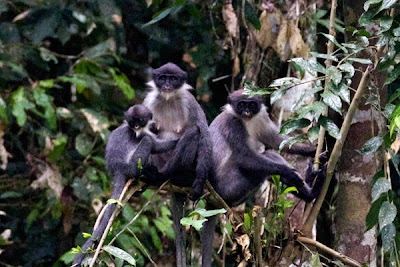'Dracula' Monkey Comes Back From The Dead In Borneo
By Rob Waugh (Daily Mail, UK)Last updatedat 11:33 AM on 20th January 2012
An 'extinct' monkey hasbeen rediscovered in the rainforest of Borneo by an international team ofscientists on a new expedition.
One of the rarest andleast known primates in the world, Miller's Grizzled Langur, has been foundalive - it was thought the species had been wiped out in 2004. The species hasa distinctive dark face and white, Dracula-esque 'collar' of fur.
Some of the only photosin existence of the rare animal were snapped by camera traps and have providedthe first solid evidence that it is still alive.
The endangered monkeywas discovered living in the Wehea Forest, East Kalimantan, Borneo, a largelyundisturbed rainforest where it was previously not known to exist.
One of the rarest andleast known primates in the world, Miller's Grizzled Langur, has been foundalive - it was thought the species had been wiped out in 2004. The species hasa distinctive dark face and white, Dracula-esque 'collar' of fur.
Some of the only photosin existence of the rare animal were snapped by camera traps and have providedthe first solid evidence that it is still alive.
The endangered monkeywas discovered living in the Wehea Forest, East Kalimantan, Borneo, a largelyundisturbed rainforest where it was previously not known to exist.
Brent Loken, from SimonFraser University Canada, said: 'While our finding confirms the monkey stillexists in East Kalimantan, there is a good chance that it remains one of theworld's most endangered primates.'
'I believe it is a race against time to protect many species inBorneo. It is difficult to adopt conservation strategies to protect specieswhen we don't even know the extent of where they live.'
The Miller's GrizzledLangur is part of the small primate genus Presbytis, found across Borneo,Sumatra, Java and the Thai-Malay Peninsula.
In Borneo, it was onlyfound in a small corner of the county's north east and its habitat has sufferedfrom fires, human habitation and conversion of land for agriculture and mining.
'I believe it is a race against time to protect many species inBorneo. It is difficult to adopt conservation strategies to protect specieswhen we don't even know the extent of where they live.'
The Miller's GrizzledLangur is part of the small primate genus Presbytis, found across Borneo,Sumatra, Java and the Thai-Malay Peninsula.
In Borneo, it was onlyfound in a small corner of the county's north east and its habitat has sufferedfrom fires, human habitation and conversion of land for agriculture and mining.
But the team ofscientists stumbled upon the monkey when trekking through the 38,000 hectarerainforest which contains at least nine known species of non-human primate,including the Bornean orangutan and gibbon.
Mr Loken said:'Discovery of P.h canicrus was a surprise since Wehea Forest lies outside ofthis monkey's known range.
'Future research willfocus on estimating the population density for P.h. canicrus in Wehea and thesurrounding forest.'
'Concern that thespecies may have gone extinct was first raised in 2004, and a search forthe monkey during another expedition in 2008 supported the assertion that thesituation was dire.'
His team spotted theprimate by watching mineral licks where animals congregate and setting upcamera traps in the areas west of its previously recorded geographical range.
Mr Loken said: 'It wasa challenge to confirm our finding as there are so few pictures of this monkeyavailable for study.'
'The only description ofMiller's Grizzled Langur came from museum specimens. Our photographs from Weheaare some of the only pictures that we have of this monkey.'
Mr Loken said: 'It wasa challenge to confirm our finding as there are so few pictures of this monkeyavailable for study.'
'The only description ofMiller's Grizzled Langur came from museum specimens. Our photographs from Weheaare some of the only pictures that we have of this monkey.'
Dr Stephanie Spehar,from the University of Wisconsin Oshkosh, added: "East Kalimantan can be achallenging place to conduct research, given the remoteness of many remainingforested areas, so it isn't surprising that so little is known about thisprimate.
'We are very grateful toour local partners.
'This discoveryrepresents the hard work, dedication, and collaboration of Western andIndonesian scientists, students, NGOs, as well as local communities andgovernment.
The team's findings arepublished in the American Journal of Primatology.
SamCooke: Wonderful World (1960) (link)
'We are very grateful toour local partners.
'This discoveryrepresents the hard work, dedication, and collaboration of Western andIndonesian scientists, students, NGOs, as well as local communities andgovernment.
The team's findings arepublished in the American Journal of Primatology.
SamCooke: Wonderful World (1960) (link)





No comments:
Post a Comment